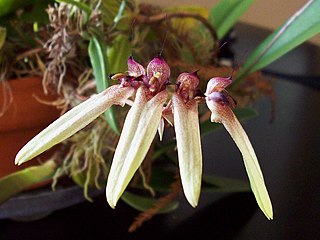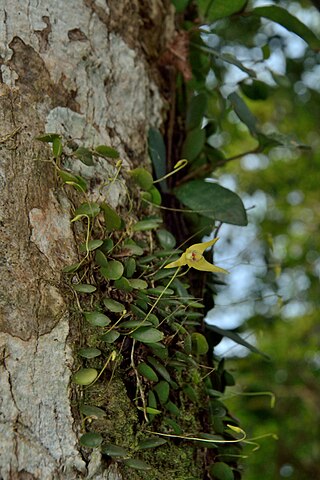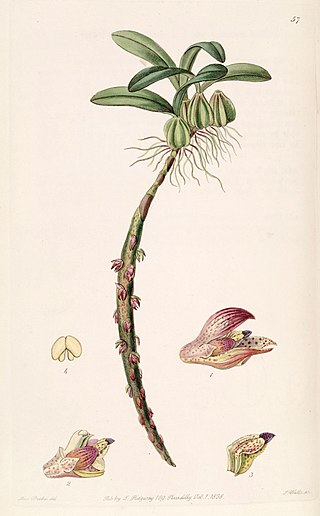
Bulbophyllum is a genus of mostly epiphytic and lithophytic orchids in the family Orchidaceae. It is the largest genus in the orchid family and one of the largest genera of flowering plants with more than 2,000 species, exceeded in number only by Astragalus. These orchids are found in diverse habitats throughout most of the warmer parts of the world including Africa, southern Asia, Latin America, the West Indies, and various islands in the Indian and Pacific Oceans. Orchids in this genus have thread-like or fibrous roots that creep over the surface of trees or rocks or hang from branches. The stem is divided into a rhizome and a pseudobulb, a feature that distinguished this genus from Dendrobium. There is usually only a single leaf at the top of the pseudobulb and from one to many flowers are arranged along an unbranched flowering stem that arises from the base of the pseudobulb. Several attempts have been made to separate Bulbophyllum into smaller genera, but most have not been accepted by the World Checklist of Selected Plant Families.
Bulbophyllum tokioi is a species of plant in the family Orchidaceae. It is endemic to Taiwan. It was described in 1935 by Noriaki Fukuyama.
Bulbophyllum lichenoides is a species of orchid in the genus Bulbophyllum. This plant is non-poisonous. It is found in New Guinea on trees in range forests at elevations around 800 meters as a mini-miniature sized, warm growing epiphyte with barely noticeable, cylindrical pseudobulbs carrying a single, apical, patent, oblong, obtuse leaf that blooms in the late winter and early spring on an erect, short to 0.12" (3 mm) long, single flowered inflorescence.
Bulbophyllum xanthornis is a species of orchid in the genus Bulbophyllum.
Hopia obtusa is a species of grass commonly known as vine mesquite. This plant was treated as Panicum obtusum until recently when more molecular and genetic material revealed new information about it. Hopia obtusa is now placed in the monotypic genus Hopia.

Digitaria insularis is a species of grass commonly known as sourgrass. It is native to Central and South America and the southern parts of the United States and has been introduced into other parts of the world. It was first described by the German botanist Friedrich Karl Georg Fedde in 1904.
Goldbachia is a genus of flowering plants belonging to the family Brassicaceae.
Quercus langbianensis is an uncommon oak tree species in the family Fagaceae. It is placed in subgenus Cerris, section Cyclobalanopsis, the ring-cupped oaks. These differ from other Quercus groups in that they have acorns with distinctive cups: usually with substantial rings, made-up of scales that have grown together. This species can be found in sub-tropical and tropical seasonal forests of Cambodia, China and Vietnam.
Passiflora quetzal is a species of flowering plant native to Mexico and Guatemala described in 2004. It is named after the quetzal, which inhabits the area.

Bulbophyllum sect. Cirrhopetalum is a section of the genus Bulbophyllum. The taxon name comes from Latin cirrus (fringe) and Greek petalon (petal), hence meaning fringed-petaled.

Bulbophyllum sect. Trias is a section of the genus Bulbophyllum.

Bulbophyllum sect. Aeschynanthoides is a section of the genus Bulbophyllum.

Bulbophyllum sect. Bulbophyllaria is a section of the genus Bulbophyllum. It is one of six Bulbophyllum sections found in the Americas.
Bulbophyllum sect. Xiphizusa is a section of the genus Bulbophyllum. It is one of six Bulbophyllum sections found in the Americas.

Bulbophyllum sect. Micranthae is a section of the genus Bulbophyllum. It is one of six Bulbophyllum sections found in the Americas.

Bulbophyllum sect. Napelli is a section of the genus Bulbophyllum. It is one of six Bulbophyllum sections found in the Americas.
Bulbophyllum sect. Biflorae is a section of the genus Bulbophyllum.
Bulbophyllum sect. Altisceptrum is a section of the genus Bulbophyllum.
Bulbophyllum sect. Saurocephalum is a section of the genus Bulbophyllum.
Bulbophyllum sect. Pseudopelma is a section of the genus Bulbophyllum.














